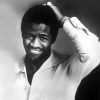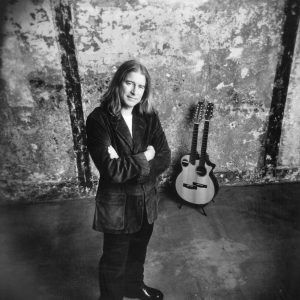calsfoundation@cals.org
Richard Leo Johnson (1955–)
Richard Leo Johnson is an architectural and fine-art photographer whose early work documented everyday experience in northern Louisiana and southern Arkansas, where he was raised. Johnson is also a renowned guitarist and composer who has released albums of virtuosic instrumental music on the Blue Note and Cuneiform labels.
Richard Johnson was born in El Dorado (Union County) to A. J. Johnson and Nadine Johnson on May 18, 1955, his mother’s birthday and parents’ anniversary. He grew up there with his brother, Joe, and sister, Carol Ann, graduating from El Dorado High School in 1973. As a teenager, Johnson was given a homemade cassette containing two albums: on one side was The Inner Mounting Flame by John McLaughlin’s jazz–rock band the Mahavishnu Orchestra, and on the other was Greenhouse by twelve-string fingerpicker Leo Kottke. Believing the wildly divergent albums to be by the same artist, Johnson’s creative horizons were blown open, and he began experimenting with his own invented tunings and techniques. When he was eighteen, Johnson encountered the work of photographer Eugene Smith in Life magazine and began taking his own photos while on a family vacation.
Johnson attended the University of Arkansas (UA) in Fayetteville (Washington County), graduating with a BFA in printmaking in 1977. In 1976, Johnson received a prestigious Time Life New Discoveries nomination by the Harlem Renaissance photographer James Van Der Zee. During his time in Fayetteville, Johnson became a part of the vibrant literary community anchored by poet and UA professor Miller Williams. Through poet Ralph Adamo, he met poets Frank Stanford and C. D. Wright and provided cover artwork for the earliest volumes published by Stanford’s Lost Roads Press. After Stanford’s suicide in 1978, Johnson was asked by the family to photograph his funeral at Subiaco (Logan County).
In 1981, Johnson married Jane Fischer, whom he had met during freshman orientation at UA.
After receiving an MFA from Louisiana Tech University, Johnson began working for internationally renowned architectural photographer Tim Hursley in Little Rock (Pulaski County) in 1983. Five years later, Johnson started his own architectural photography business, relocating to Eureka Springs (Carroll County). The Johnsons’ only child, daughter Tess, was born in 1990.
In the summer of 1995, Johnson’s family lost almost everything they owned in a storage barn fire, including his entire photography archive. The devastating loss prompted him to shift toward his other longtime passion: music. Shortly thereafter, Johnson and his wife and child relocated to Nashville, Tennessee, and Johnson received an endorsement by Taylor Guitars. In 1998, he signed to Blue Note Records, releasing two albums, Fingertip Ship and Language, and touring widely in North America and Europe. In 2000, feeling strained by a musician’s lifestyle, the Johnsons moved to Savannah, Georgia, where Johnson revived his architectural photography career.
One day in 2015, Johnson’s old friend and former assistant Russell Powell called from Little Rock with incredible news. In a forgotten cardboard box in his parents’ attic, Powell discovered a trove of black-and-white film. They were hundreds of Johnson’s negatives from early in his career, selections the pair had made for a project that was never realized. Powell sent the box to the Johnsons, who cried when they opened it, recognizing hundreds of photographs from Johnson’s early career: portraits of family, friends, and strangers he had taken from the late 1970s to the mid-1980s. The astonishing discovery reinvigorated Johnson, and he decided to exhibit the project as “Once Was Lost…” and asked his old friend from the Fayetteville days, C. D. Wright, to compose some text to accompany the show. Wright delivered what would prove to be one of her final compositions, a poem titled, “What Do You Think’s In the Shed,” two weeks before her untimely death. The collaboration was published in the Spring 2016 issue of the Oxford American magazine.
Johnson remains active in the dual artistic pursuits that have shaped his life’s path: guitar playing and photography. He continues to compose and release music, with more than five albums to his name. His architectural photography has been published in Coastal Living, Cottage Living, This Old House, Southern Accents, and Architectural Record. His fine-art work has been selected for several exhibitions and private collections, including at the New Orleans Museum and the Arkansas Museum of Fine Arts.
For additional information:
Johnson, Richard Leo, and C. D. Wright. “Once Was Lost.” Oxford American (Spring 2016): 112–118.
Smittle, Stephanie. “A Q&A with Guitarist-Photographer Richard Leo Johnson.” Arkansas Times, December 8, 2016. https://arktimes.com/rock-candy/2016/12/08/a-qa-with-guitarist-photographer-richard-leo-johnson (accessed May 24, 2022).
“Richard Leo Johnson.” Cuneiform Records. http://cuneiformrecords.com/bandshtml/rlj3.html (accessed May 24, 2022).
Maxwell George
Brooklyn, New York



 Richard Leo Johnson
Richard Leo Johnson  Richard Leo Johnson
Richard Leo Johnson  Richard Leo Johnson
Richard Leo Johnson 



Comments
No comments on this entry yet.